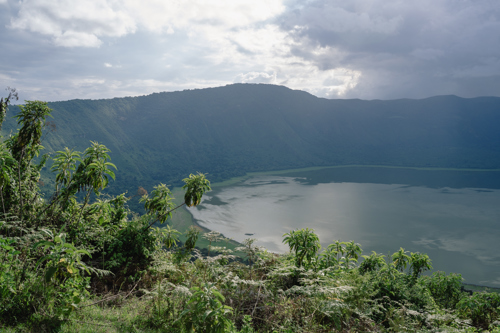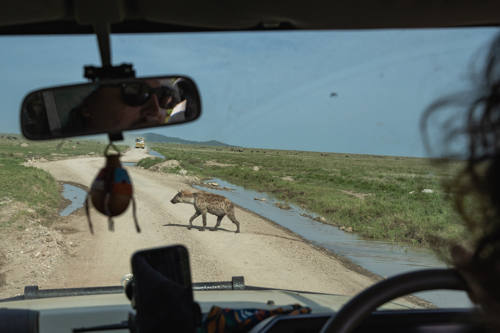All you need to know about travelling to Ngorongoro
Few safari destinations deliver the same experience as the Ngorongoro Crater. There are bigger and wilder parks out there, but if you want some of the easiest and most rewarding game viewing in East Africa, travelling to the Ngorongoro Crater will not disappoint.
The Ngorongoro is an ideal destination for first-time safari visitors, families and self-drivers, and lies within easy reach from Arusha. The crater's ancient volcanic caldera is said to be home to some 30,000 animals, predators are abundant, and it's not unusual to see the Big 5 in one single day.
Planning to visit the Ngorongoro Conservation Area during your travels in Tanzania? Then this article is for you!

Can I explore the Ngorongoro on a self-drive safari?
The Ngorongoro Crater is a very easy and suitable park to explore on a Tanzania self-drive safari. Although the NCA wardens at the entrance gate will advise you to take a ranger guide, this is not compulsory and, in our opinion, not needed either. The safari tracks on the crater floor are well-maintained and signposted, and it's impossible to get lost in Ngorongoro.
Ngorongoro permits & entrance fees
Travelling the Ngorongoro Crater requires a permit. Once obtained, you'll have access to the park from 6 AM to 6 PM. A half to full day is enough to cover the main tracks in the crater.
To enter Ngorongoro, a tour operator will have to arrange and issue your permit for you in advance. Roadtrip Africa is happy to help you organize your NCA reservation. Please select this option in our bookings form when renting your car. We charge a handling fee of € 25 in total.
For a clear overview of the entrance fees to Ngorongoro, Serengeti and other national parks in Tanzania, we gladly refer you to our Tanzania National Park Fees & Permits - page.
Travelling to the Ngorongoro Crater
Understanding the driving times in Tanzania is crucial for a smooth trip. Here's a breakdown:
- Arusha to Karatu (last town for groceries) – 140 km in about 3 hours on a smooth tarmac road
- Karatu to Loduare gate (Ngorongoro Conservation Area entrance) – 15 km in about 30 min
- Loduare gate to Ngorongoro Crater entrance – 15 km in about 1 hour
- Ngorongoro Crater entrance to Naabi Hill Gate (Serengeti entrance) - 85 km in about 2 - 3 hours.
Distance from Ngorongoro to Serengeti National Park
Your NCA permit is valid for 24 hours. It's possible to visit the Ngorongoro Crater within that time before driving to Serengeti, but you must time it wisely. Driving from Ngorongoro to Serengeti takes 2-3 hours. We, therefore, advise entering the Ngorongoro Conservation Area in the late afternoon, starting your crater safari the following morning, and leaving on time to drive to Serengeti. Another option is to enter Ngorongoro in the late morning, go on safari for the rest of the afternoon, camp, and leave for Serengeti early the next morning.
For more itinerary tips and mapped-out routes in Tanzania, feel free to visit our itinerary page here.
The best time to visit Ngorongoro
Ngorongoro's wildlife resides in the crater year-round. Therefore, choosing the ideal time for a safari isn't about maximizing your game-viewing, but more about deciding how many people and vehicles you want to share the experience with.
In our opinion, the best time to visit the Ngorongoro Crater in Tanzania is during April and May. Yes indeed, that's during the rainy season. There are far fewer visitors this time of the year, and the crater is wonderfully lush and green compared to the dusty dry-season landscape in other months.
Are you travelling from July to September (peak season) or December to February (calving season)? Expect a high number of visitors and long queues of vehicles waiting to enter the Ngorongoro Crater. Being down at the caldera can feel very crowded around these times of year, compromising the true wilderness experience.

Camping and lodges in the Ngorongoro
Karatu is the gateway town to the Ngorongoro Conservation area and a good place to base yourself when visiting the NCA and the Ngorongoro Crater. There is plenty of accommodation on offer in Karatu ranging from budget to high-end.
If you want to stay inside the NCA, the most affordable option is self-camping at Simba Public Campsite A, located on the crater rim. More information about camping in Tanzania can be found in our camping guide.
The best lodges in the Ngorongoro
The most affordable lodge on the crater rim is Rhino Lodge - it doesn't have a view though. All the other lodges inside the NCA are beautiful but also quite expensive.
Exploring the Ngorongoro Conservation Area away from the crowds
Apart from the world-famous Ngorongoro Crater, the Conservation Area's highlands provide some great opportunities for breaking up a self-drive safari and stretching your legs. So linger around for a few more days, beat the crowds, and allow some off-the-beaten-track exploration.
The Bradt Travel Guide, which comes with your Roadtrip Tanzania car rental, is a great source of information for covering off-the-beaten-track places. Herewith, we highlight a few lesser-known sights to explore inside the Ngorongoro Conversion Area:
- Empakaai Crater: the stunning but relatively unknown Empakaai Crater lies approx. 40km northeast of the Ngorongoro Crater. From the moment you arrive at Empakaai, you will be treated to splendid views of the Empakaai Crater and get a glimpse of Oldoinyo Lengai, Tanzania’s most active volcano. It's a 45-minute descent into the crater through thick, mountainous forest. Down on the crater floor, you'll find superb birding around the lake, and the chance to see flamingos and some big game like buffalo, hyena and elephant.
- Olduvai Gorge: If you are interested in ancient history, visit Olduvai Gorge (aka Oldupai), one of the most important palaeoanthropology sites in the world, including a small museum. It is renowned for its early hominin fossils, stone tools, and plant and mammal fossils. At Laetoli, hominid footprints of our genetic ancestors have been found in sedimentary rock of 3.7 million years old. A 30-minute drive from Olduvai, you can find a curious phenomenon: a shifting dune. This dune is formed from fine volcanic ash, which is highly magnetic due to its high iron content. This means the dune clings together and acts as a single unit as it slowly moves across the landscape.
- Gol Mountains: Meaning Mountains of God, the Gol Mountains provide a surreal wilderness environment of stark, pink cliffs enclosing the Angata Kiti pass, providing a bottleneck for the annual Great Migration of hundreds of thousands of wildebeest and zebra. This remains one of the most traditional corners of Tanzania, home to the Masaai, who still kill lions as their rite of passage into warriorhood and largely live outside the cash economy. Don't expect a 'cultural tour' visiting the Masaai to bring you a genuine experience. Instead, we recommend going on a guided walking safari with a local tour guide and learning more about Masaai culture and this spiritual place.
Taking off on your Ngorongoro self-drive travels
Are you ready to rent a car and explore Ngorongoro on a self-drive safari? Get in contact with our experienced team at Roadtrip Africa to check availability, and secure your 4x4 now!